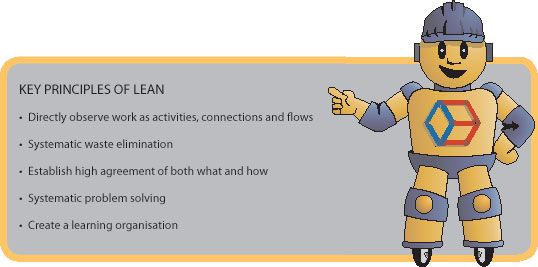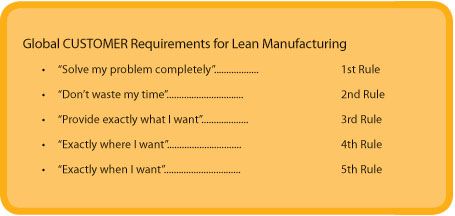
Lean Production
Definition
Lean manufacturing systems use a systematic approach to identify and eliminate waste through continuous improvement by allowing the flow of the product only when the customer needs it.
Error Free Production
Error free production means first time quality. By stopping production when a defect is detected, defects are prevented from traveling on to the next process, and can be located and solved quickly and efficiently.
Lean Manufacturing Concepts
- 5S
- One Piece Flow (Cell Manufacturing)
- Poka Yoke
- Single Minute Exchange of Dies (SMED)
- Visual Controls
- Waste Elimination
- Zero Defects

Main objectives to eliminate waste (7 deadly wastes/Mudas)
Some of the key principles of "lean" includes the elimination of waste, and the creation of value added work and efficiency.
Waste of:
- Overproduction
- Defective Workmanship
- Excessive effort
- Excess inventory
- Waste of conveyance
- Waste of motion
- Waiting
Matching of lean production process to a lean consumption process
Traditional system
- Starts in factory - Ends with customer
- Production plan based on demand
- Material procurement to meet production plan
- Material receipt & inspection
- Storage of materials & components (Until required for processing)
- Actual production on various stations with stress on maximising production
- Assembly, final inspection & packaging
- Storage of finished goods.
Closing the gap between customer & factory
- Begins at home
- Home is the market of sale, the place where the customer lives
- Manufacturers to think forward from the order point and shipping dock rather than backward through the factory & value stream
- Is most important and feasible in home market of manufacturers
- Is a critical challenge for future success.
Continuous Improvement Processes
(If unsuccessful, return to step 4)

- Communicate with team members
- Capture the current situation
- Determine the target/ideal situation
- Identify problems
- Generate counter-measures
- Test counter-measures
- Re-adjust & re-balance wall
- Implement new methods
- Monitor & modify (SOS)
- Evaluate improved situation
Standardise & follow up.
